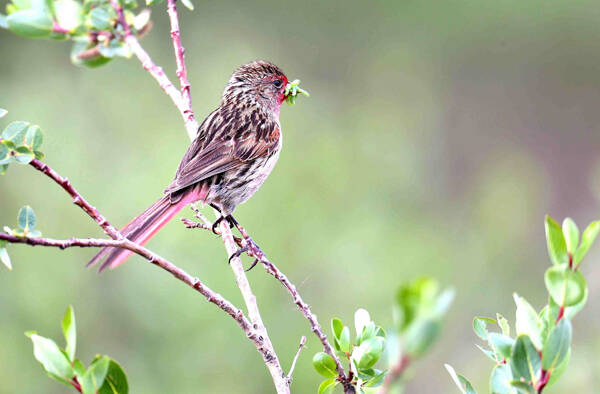Urocynchramus pylzowi
IUCN
LCBasic Information
Scientific classification
- name:Urocynchramus pylzowi
- Scientific Name:Urocynchramus pylzowi,Pink-tailed Bunting,Pink-tailed Rosefinch,Ground hemp
- Outline:Songbird
- Family:Passeriformes C.Bunting
Vital signs
- length:14-17cm
- Weight:15-20g
- lifetime:20-30years
Feature
There is a gap between the upper and lower edges of the mouth, and the upper edge of the mouth is swollen near the base
Distribution and Habitat
Endemic to China, it is distributed in Gansu (northwest), Qinghai (eastern, mountainous areas south of Qinghai Lake and the upper reaches of Jinsha River), Sichuan (western Shiqu and Batang), and eastern Tibet at an altitude of 3000-5000 meters.
Although the red bunting is a mountain bird, it does not live in mountainous areas with high altitudes, generally at an altitude of 500-2500 meters. It inhabits dwarf willows and small shrubs on both sides of valleys and mountain streams. This bird is endemic to China, but its number is rare and its distribution is narrow.
Appearance
Adult male: head and upper body are almost pure sandy brown with brown vertical stripes, the back of the neck is light in color, stained with light rose red; small wing feathers and small coverts are the same color, wing coverts and flight feathers are brown, feather edges are dark brown, and wing edges are pink; the central tail feathers are dark brown, feather edges are light brown, the outer tail feathers and undertail coverts are pink, and the tips are light. Most individuals have no brown spots on the outermost pair of tail feathers, and the second pair has brown tip spots; the eyebrow, eye, under the eye, chin, throat, and chest are all rose red, and the abdomen is light to dirty white; the underwing coverts and armpits are dirty white.
Adult female: The whole body is light yellow brown with darker stripes, and the base of the tail feathers is light pink orange.
Juvenile male: The plumage is similar to that of the female. The pink parts of the eyebrow, eyebrow, chin, throat
Details
Pink-tailed Bunting is a species of the family Pinnipedae, with no subspecies.

Pink-tailed Bunting is usually silent. Its call is a rapid chitri-chitri-chitri-chitri. It emits a clear, silvery bell-like call of "kvuit, kvuit" when flying or giving warning. The red bunting usually moves alone, in pairs or in small groups. It flies weakly but flaps its wings frequently. It lives in alpine meadows or shrubs, and mainly feeds on weed seeds and insects.
The breeding season of the red bunting is from May to August. It builds its nest on branches with dense leaves, about one meter above the ground.
It is included in the "List of Terrestrial Wildlife with Important Economic and Scientific Research Value under State Protection" (item 678) issued by the State Forestry Administration of China on August 1, 2000.
Listed in the IUCN Red List of Threatened Species in 2016 ver 3.1 - Least Concern (LC).
Listed in China's National List of Key Protected Wildlife (February 5, 2021) Level 2.
Protect wildlife and eliminate game.
Maintaining ecological balance is everyone's responsibility!








